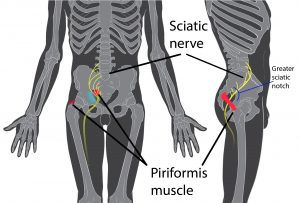WHAT IS PIRIFORMIS SYNDROME?
 The piriformis muscle is a flat band-like muscle in the buttocks near the top of the hip joint. This muscle is important in lower body movement as it stabilizes the hip joint and lifts and rotates the thigh away from the body. Piriformis syndrome occurs when this muscle presses on your sciatic nerve that goes from the spinal cord and down the back of each leg. This can cause pain and numbness in your lower body and leg. Sciatica may start as an intense burning pain or an ache deep inside the buttocks and the pain gets worse during activities that cause the piriformis muscle to press against the sciatic nerve.
The piriformis muscle is a flat band-like muscle in the buttocks near the top of the hip joint. This muscle is important in lower body movement as it stabilizes the hip joint and lifts and rotates the thigh away from the body. Piriformis syndrome occurs when this muscle presses on your sciatic nerve that goes from the spinal cord and down the back of each leg. This can cause pain and numbness in your lower body and leg. Sciatica may start as an intense burning pain or an ache deep inside the buttocks and the pain gets worse during activities that cause the piriformis muscle to press against the sciatic nerve.
WHAT IRRITATES THE PIRIFORMIS MUSCLE?
Piriformis syndrome can develop from everyday activities such as sitting for long periods, climbing stairs, walking or running. It can also develop after a traumatic event such as a car accident or fall.
HOW CAN PIRIFORMIS SYNDROME BE PREVENTED OR AVOIDED?
To prevent piriformis syndrome developing, regular exercise can help but make sure you stretch and warm up first. Maintain good posture when sitting, driving or standing. Do not lit by bending over but bend your knees and squat to pick up heavy objects. Keep the back straight and hold the object close to the body. Avoid twisting the body when lifting. Avoid sitting or lying down for long periods of time in a position that puts too much pressure on the buttocks.
TREATMENT FOR PIRIFORMIS SYNDROME
Piriformis syndrome is often caused by imbalance in the pelvis and this is easily treated with chiropractic manipulation. Most people who have piriformis syndrome get better with treatment and lifestyle changes. Failure to treat this condition can lead to permanent nerve damage. Therefore be sure to follow the advice of your healthcare provider. Self care tips include the following:
- Use cold and warm packs on the affected area.
- Taking a non-steroidal anti-inflammatory (NSAID)
- Doing exercises that stretch the piriformis muscle.
- Take regular breaks to walk around and stretch if you have to sit for a long period of time.
If your pain does not improve with self treatment, your doctor may refer you to a chiropractor or inject a steroid medicine where the piriformis muscle and sciatic nerve meet.

